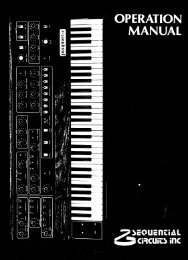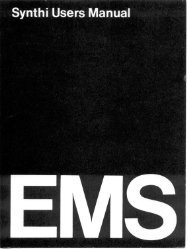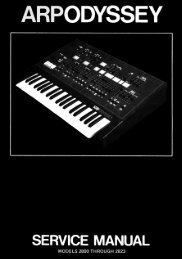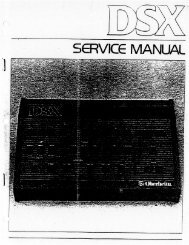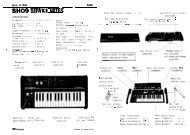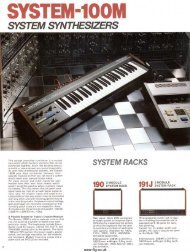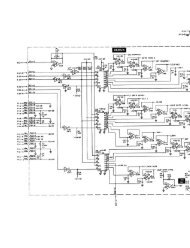ARP2600 - Fundamentals of Music Technology - Cyborgstudio.com
ARP2600 - Fundamentals of Music Technology - Cyborgstudio.com
ARP2600 - Fundamentals of Music Technology - Cyborgstudio.com
You also want an ePaper? Increase the reach of your titles
YUMPU automatically turns print PDFs into web optimized ePapers that Google loves.
004 - SECTION ONE: GENERAL CONTROLSPARAMETERS AND VALUESSoon the synthesizer’s functions will be explained, but it is important to first understand the concept <strong>of</strong>a parameter. A parameter is simply something that one can change. A value is one <strong>of</strong> the possiblesettings <strong>of</strong> a parameter. For instance, if Bob looks at a light switch, he can see that the switch itselfrepresents the parameter. It is something whose value he can change. This parameter has two possiblevalues: On and Off. A fader, on the other hand, is said to have an infinite number to values, although itsrange <strong>of</strong> values may be measurable.PATCH CABLESThin cables called patch cords or patch cables (See Figure 1-5) are used toconnect different parts <strong>of</strong> the synthesizer together. They consist <strong>of</strong> twoplugs which have been soldered to either end <strong>of</strong> a length <strong>of</strong> wire. Thiswire can be <strong>of</strong> any length. Some setups <strong>of</strong>fer cables <strong>of</strong> just one length,while other setups have many different lengths <strong>of</strong> cables. The cablesARP included with the 2600 were all <strong>of</strong> the same length, but few <strong>of</strong>them are still around today as the wire has usually deteriorated to thepoint where the cables are unreliable. Many owners <strong>of</strong> 2600’s todayeither purchase cables from <strong>com</strong>panies which specialize in cables ormake their own from parts acquired from electronics stores and supplyhouses.Figure 1-5: Twohomemadepatch cordsPatch cables are pretty durable, but one must take care <strong>of</strong> them if theyare expected to last a long time. First, don’t ever leave them lying aroundon the floor as they can be stepped on or worse yet, rolled over with achair. Second, whenever a patch cord is removed from ajack in the ARP’s cabinet, pull it out by the plug ratherthan by the cord. It is entirely possible to rip the cord right <strong>of</strong>f <strong>of</strong> the plug if it ispulled hard enough, because the only thing holding the two together is a drop <strong>of</strong> solder.Third, do not bend the cable itself at tight angles, as doing so can actually sever the wire inside thecasing. Finally, when finished with them, patch cords should be stored in a safe location, away fromextreme heat and <strong>of</strong>f the floor where they could be<strong>com</strong>e damaged. A simple hook mounted on a wall orthe side <strong>of</strong> a table is a great place to store patch cables.Many studios use two different colors <strong>of</strong> patch cables when patching the ARP 2600; red and black. Thecables are identical other than the color <strong>of</strong> the plug and/or wire casing, and don’t function any differently,but they are used for different purposes to make it easier to understand the way the synthesizerworks. For audio signals, black cables are used. Audio signals are signals that are the raw sound thatone eventually wants to hear. Red cables are used to carry control signals. Control signals are signalswhich one doesn’t intend to hear and which will be used strictly to effect change on some other part <strong>of</strong>the synthesizer. (The difference between audio and control signals will be<strong>com</strong>e clearer in time.) Thenext section contains a great deal more information about control signals. For now, just remember thatblack is used for audio signals, and red is used for control signals.




